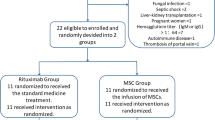Abstract
Objective: To study the effect and implication of nonmyeloablative donor specific bone marrow (DSBM) infusion on the immunoreaction of liver allotransplantation. Methods: Orthotopic liver transplantation model was used in this study. Groups were set as follows: Group I, syngeneic control (Wistar-to-Wistar); Group II, acute rejection (SD-to-Wistar); Group III, acute rejection treated with cyclosporine A (CsA) by intramuscular injection (SD-to-Wistar+CsA); Group IV, bone marrow infusion at 7 d pretransplantation followed by short-term CsA treatment (SD-to-Wistar+DSBM); Another group of short-term CsA treatment preoperatively without bone marrow infusion was also set as control. General characteristics and survival time were observed. Histological grades of rejection were determined by pathological examination. IL-2 and IFN-γ level in peripheral blood and donor liver were detected respectively by Enzyme-Linked Immuno-Sorbent Assay (ELISA) and Western blot. Chimerism of donor cells was measured by PCR for a male-specific marker (Y-chromosome-specific sequence, Sry). Results: No signs of rejection were found in Group I. Acute rejection occurred in both Group II and the short-term CsA treated group. All the recipients died at (9:_15) d posttransplantation with a median survival time of (10.7±0.5) d and (11.2±2.4) d, respectively. Only mild rejection could be seen in Group III. In Group IV, 4 out of 6 recipients had long-term survival (>100 d), the histological grade of rejection was significantly lower than that of Group II, so did the expression level of IL-2 and IFN-γ in both peripheral blood and grafted liver. Y-chromosome-specific sequence (Sry) of male SD rats could be detected in the bone marrow, spleen and thymus of female recipients at 15 d after bone marrow infusion. Conclusion: Mild preconditioning nonmyeloablative donor specific bone marrow infusion can enhance chimerism formation in recipients, alleviate the rejection of liver allotransplantation and prolong survival of liver allotransplantation.
Similar content being viewed by others
References
Alberto, S.F., Terry, B.S., 2004. Immunological tolerance and liver transplantation. Journal of Hepatology, 41(5):698–705. doi:10.1016/j.jhep.2004.09.013.
Beschorner, W.E., Yao, X., Divic, J., 1995. Recruitment of semiallogeneic dendritic cells to the thymus during post-cyclosporine thymic regeneration. Transplantation, 60(11):1326–1330.
Gao, E.K., Lo, D., Cheney, R., Kanagawa, O., Sprent, J., 1988. Abnormal differentiation of thymocytes in mice treated with cyclosporine A. Nature, 336(6195):176–179. doi:10.1038/336176a0.
Hale, D.A., Gottschalk, R., Umemura, A., Maki, T., Monaco, A.P., 2000. Establishment of stable multilineage hematopoietic chimerism and donor-specific tolerance without irradiation. Transplantation, 69(7):1242–1251. doi:10.1097/00007890-200004150-00008.
Jenkins, M.K., Schwartz, R.H., Pardoll, D.M., 1988. Effects of cyclosporine A on T cell development and clonal deletion. Science, 241(4873):1655–1658.
Jia, C.K., Zheng, S.S., Zhang, A.B., 2003. Intrathymic inoculation of donor liver specific antigen alleviates rejection of liver allotransplantation. Journal of Zhejiang University Science, 4(4):485–490.
Joseph, S., David, W.R., 2000. Molecular Cloning: A Laboratory Manual on the Web, 3rd Ed. Cold Spring Harbor Laboratory (CSHL) Press, New York, p.127–128.
Kemnitz, J., Ringe, B., Cohnert, T.R., Gubernatis, G., Choritz, H., Georgii, A., 1989. Bile duct injury as a part of diagnostic criteria for liver allograft rejection. Hum. Pathol., 20(2):132–143. doi:10.1016/0046-8177(89)90177-9.
Kita, Y., Li, X.K., Ohba, M., Funeshima, N., Enosawa, S., Tamura, A., Suzuki, K., Amemiya, H., Hayashi, S., Kazui, T., Suzuki, S., 1999. Prolonged cardiac allograft survival in rats systemically injected adenoviral vectors containing CTLA4Ig-gene. Transplantation, 68(6):758–766. doi:10.1097/00007890-199909270-00007.
Kobayashi, E., Kamada, N., Goto, S., Miyata, M., 1993. Protocol for the technique of orthotopic liver transplantation in the rat. Microsurgery, 14(8):541–546.
Lee, W.C., Jeng, L.B., Chiang, Y.J., Wang, H.C., Huang, C.C., 2000. Dendritic cell progenitors prolong allograft survival through T-helper 2 deviation of the Th1/Th2 paradigm. Transplant Proc., 32(7):2076–2077.
Li, S., Thanikachalam, M., Pang, M., Kawaharada, N., Aitouche, A., Pham, S.M., 2001. A clinically relevant CTLA4-Ig-based regimen induces chimerism and tolerance to heart grafts. Ann. Thorac. Surg., 72(4):1306–1310. doi:10.1016/S0003-4975(01)03066-1.
Liu, J., 1993. FK506 and cyclosporine, molecular probes for studying intracellular signal transduction. Immunol. Today, 14(6):290–295. doi:10.1016/0167-5699(93)90048-P.
Manilay, J.O., Pearson, D.A., Sergio, J.J., Swenson, K.G., Sykes, M., 1998. Intrathymic deletion of alloreactive T cells in mixed bone marrow chimeras prepared with a nonmyeloablative conditioning regimen. Transplantation, 66(1):96–102. doi:10.1097/00007890-199807150-00015.
Petersen, B.E., Bowen, W.C., Patrene, K.D., Mars, W.M., Sullivan, A.K., Murase, N., Boggs, S.S., Greenberger, J.S., Goff, J.P., 1999. Bone marrow as a potential source of hepatic oval cells. Science, 284(5417):1168–1170. doi:10.1126/science.284.5417.1168.
Raimondo, M.L., Burroughs, A.K., 2002. Single-agent immunosuppression after liver transplantation: what is possible? Drugs, 62(11):1587–1597.
Shirasugi, N., Adams, A.B., Durham, M.M., Lukacher, A.E., Xu, H., Rees, P., Cowan, S.R., Williams, M.A., Pearson, T.C., Larsen, C.P., 2002. Prevention of chronic rejection in murine cardiac allografts: a comparison of chimerism-and nonchimerism-inducing costimulation blockade-based tolerance induction regimens. J. Immunol., 169(5):2677–2684.
Theise, N.D., Badve, S., Saxena, R., Henegariu, O., Sell, S., Crawford, J.M., Krause, D.S., 2000. Derivation of hepatocytes from bone marrow cells in mice after radiation-induced myeloahlation. Hepatology, 31(1):235–240. doi:10.1002/hep.510310135.
Urdahl, K.B., Pardoll, D.M., Jenkins, M.K., 1994. Cyclosporin A inhibits positive selection and delays negative selection in αβ TCR transgenic mice. J. Immunol., 152(6):2853–2859.
Author information
Authors and Affiliations
Corresponding author
Additional information
Project (No. 2003CB515501) supported by the National Basic Research Program (973) of China
Rights and permissions
About this article
Cite this article
Xie, Hy., Huang, Ds., Jia, Ck. et al. Infusion of nonmyeloablative bone marrow alleviates acute rejection reaction in liver allotransplantation. J. Zhejiang Univ. - Sci. B 6, 1188–1194 (2005). https://doi.org/10.1631/jzus.2005.B1188
Received:
Accepted:
Published:
Issue Date:
DOI: https://doi.org/10.1631/jzus.2005.B1188




